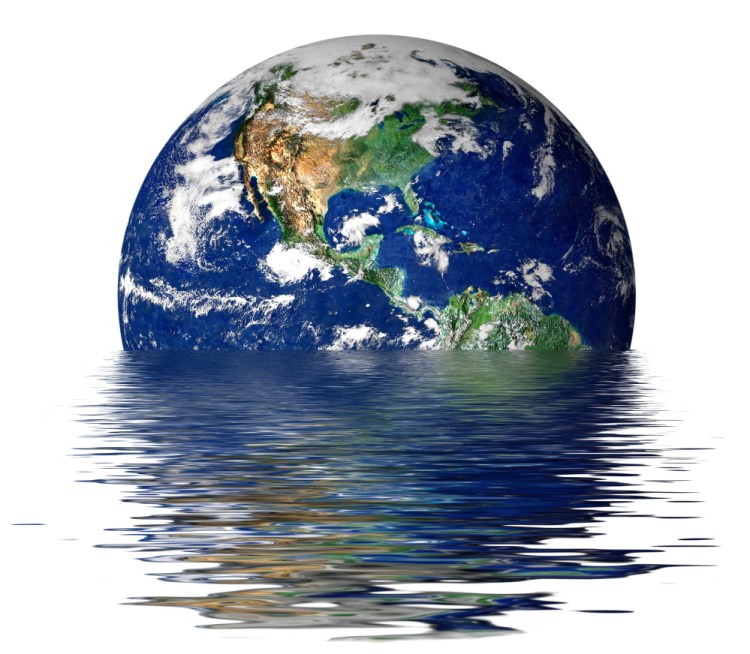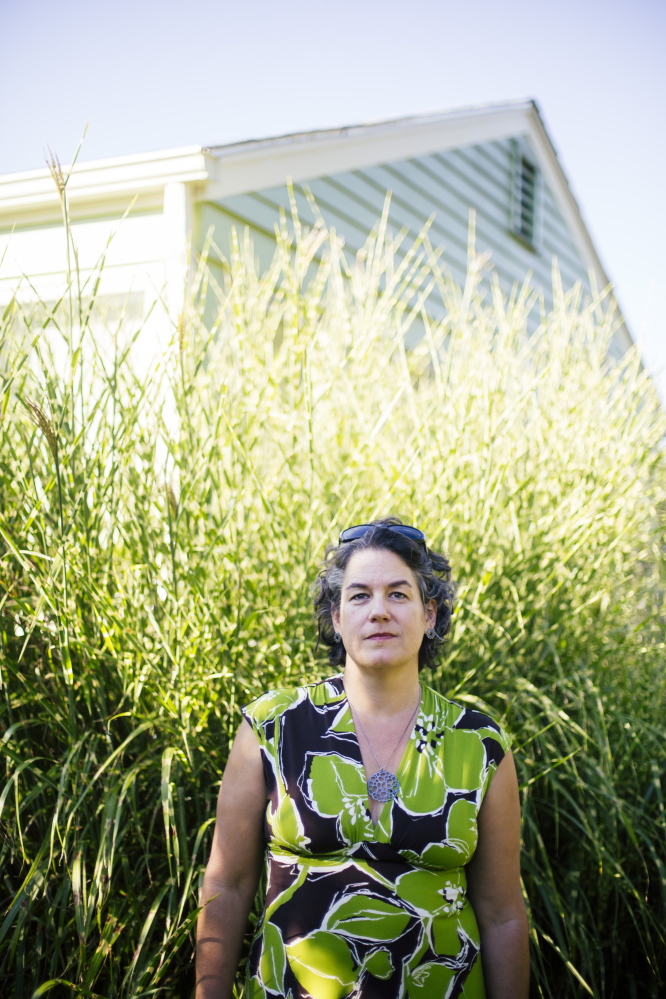In early August, as a freakish hailstorm ripped through her Deering neighborhood, Jeanne Paterak pulled out her smartphone and shot some video of the hail – which meteorologists later said were pingpong-ball sized – as it pounded her yard and piled up on her patio. She and her two children were enthralled, although she was worried about her friend’s new Honda parked in the driveway.
After the worst of the storm had played itself out, she took a quick look at the urban “mini-farm” on her family’s half-acre plot. There were peaches and pears on the ground and the pumpkins had been treated nearly as roughly as if a crew of disaffected Halloween trick-or-treaters had stomped through the patch. Maybe the bruised and beaten tomatoes would rebound.
She didn’t visit the garden until late in the next day, only venturing out after her husband came in and reported that it looked awful. Two of the solar hot water tubes on their roof were broken, 85 percent of the tomatoes and 70 percent of the fruit ruined, many of their row crops damaged.
As many of us are wont to do when we’re feeling sad, mad or bad, Paterak Googled. She was disappointed that news coverage of the hail didn’t include any mention of the big picture; it seemed to her that such a sudden and
extreme weather phenomenon had to be associated with climate change. Meteorologists had noted that such violent hail was unusual in Portland, where the cooler, stable air coming off the ocean doesn’t customarily produce the kind of conditions that create hail. But Rolling Stone had coincidentally published a story that day, titled “The Point of No Return: Climate Change Nightmares Are Already Here.”
When you’re feeling sad, mad or bad, reading about deadly heat waves in Pakistan and India, or flaming rain forests in Washington state, or the epic El Niño on the way is not a pick-me-up. It might provide comforting perspective if these places were, say, on another planet. Meanwhile Paterak noted that in Maine, a violent hailstorm had all but wiped out the apple crop at the University of Maine’s research farm in Monmouth as well as extensively damaging an orchard in Manchester.
Was this kind of punishing hailstorm the new normal, Paterak wondered? She didn’t exactly take to her bed – there was a garden to clean up after all – but she did feel a sense of despair. Was her family, with their efforts to be self-sustaining, their one (energy-efficient) car, their bike riding, their passion for canning and freezing those tomatoes, building toward resiliency or is climate change too much of a Big Bad to fight off with Priuses and homegrown peaches?
“The hardest part is juggling the worry with that sense that you’ve got to just keep doing what you can do,” Paterak said a month after the storm.
LIKE A FREIGHT TRAIN
Mankind has faced fearful end-of-days challenges throughout time, from the black plague right up through the threat of nuclear war that had schoolchildren ducking and covering under their desks in the 1950s. Climate change is different in that fixes such as a medical cure or a negotiated desire for peace aren’t available. Its parameters are slippery, hard to see.
The problem is daunting. And wearing. Particularly for those who have devoted their working lives to either studying its impacts or trying to stave them off.
“We need to have forums to talk about this,” said Cathy Ramsdell, executive director of Friends of Casco Bay. For too long, she said, it has felt “taboo as a topic, to say climate disruption and the fate of our planet and our role is getting to me today.”
“Maybe there is something to be said about just admitting how this feels,” she added.
What does it feel like? “I call it the freight train coming straight at us.”
Climate change is something Ramsdell has conversations about all the time, whether in a staff meeting at the marine stewardship’s offices or a conference or a dinner party. Then there is the latest news: those wildfires in California or typhoons hitting Japan, which in her opinion have to be attributed at least in part to climate change. It’s not just looming, it is here, here in the waters of the Gulf of Maine, warming faster than 99 percent of the world’s largest bodies of saltwater.
Sometimes – no, often – Ramsdell said she has to turn the conversation off, to turn to her workmate or dinner companion and joke, “Can we start talking about puppies and rainbows now? Because I need to feel better.”
She, like many environmentalists worldwide, has her hopes pinned on key dates. From Nov. 30 to Dec. 11, world leaders will gather for the United Nations Climate Change Conference in Paris and the agenda is huge: to come to universal agreement on climate from all of the nations in the world, and not just an understanding, but a legally binding agreement. “There’s a lot riding on the talks,” she said, admitting that if they don’t go well, she’ll be anguished.
In 2011, the American Psychological Association published a report on psychology and global climate change, taking a look at the issue from a multi-dimensional approach, including perceptions of the climate change and the propensity of some to deny what a reported 97 percent of the world’s scientists believe: The planet is warming, ice is melting, seas are rising and human beings and their waste have created an environmental crisis that is only worsening with time.
“Even individuals whose economic livelihood depends on weather and climate events (e.g. farmers or fishers) might not receive sufficient feedback from their daily or yearly personal experience to be alarmed about global warming,” the report said.
But surveys conducted in Alaska and Florida, two states where residents have had direct experience with climate change-driven changes (think melting ice and more forceful hurricanes), found “that such exposure greatly increases their concern and willingness to take action.”
In other words, if people can’t see it for themselves, they have a hard time believing it. Or doing anything about it. In sociological terms, this is known as Giddens’ paradox, named for British sociologist Anthony Giddens, who published a book on the politics of climate change in 2009. He posited the paradox that “since the dangers posed by global warming aren’t tangible, immediate or visible, in the course of day-to-day life, however awesome they appear, many will sit on their hands and do nothing.”
Mainers aren’t particularly inclined to do nothing, and a study by three UMaine professors on environment and values from the summer of 2010 found a clear majority of residents are concerned about the effect of global warming on Maine (67 percent) while only about 17 percent said they weren’t concerned (the rest were unsure). As a state, we were more worried than our fellow Americans. Nationally in that same year, a Pew Research Center poll found that 63 percent of Americans were concerned about climate change. In 2015, Pew found that percentage had risen to 69 percent.
Paterak is hardly a former denier who has been converted by an August hailstorm, an event which seemed extreme but can’t be directly connected with global warming. She is an educated believer in climate change who has been actively doing what she can, in a way that may seem small in the grander scheme of things but which is large within her own life. She’s willing to take action, but after that hailstorm, she found herself in what could be described as a heightened state of anxiety about climate change.
The American Psychological Association report covered this topic as well, addressing the mental health impacts of actual and perceived climate change. As world temperatures go up, rates of violence are expected to go up. Even the threat of climate change creates emotional distress and anxiety, researchers found.
With that comes fear, despair, a sense of being overwhelmed or powerless. From there, the path diverges. For some, being overwhelmed inhibits “thought and action” and the next step is denial, paralysis, apathy.
Based on historical responses to incidences of drought, heat waves as well as extreme weather and natural disasters, the report postulated that, for others, despair can lead to anxiety disorders, depression, sleeping disorders, drug and alcohol abuse, increasing vulnerability for those who already have severe mental health issues and even higher rates of suicide attempts. Studies of Australian farmers’ responses to drought conditions contributed to the suicide findings.
Plenty of people might dismiss anxiety as needless worrying, but as the American Psychological Association report on climate change puts it, “In clinical terms, anxiety is a future-oriented mood state associated with a sense that events are proceeding in an unpredictable, uncontrollable fashion.”
The principal function of worry, it goes on to say, “is to prepare to cope with future threats.”
CLIMATE INSECURITY
Skowhegan counselor Bob McLaughlin has been in Maine since the 1960s, working on issues such as poverty and domestic violence. About three years ago, a new mental health issue came up in his practice for the first time: climate insecurity. “That’s the sweeping term I use,” McLaughlin said. The parallel would be food insecurity, which refers to not knowing where one’s next meal is coming from.
His first encounter was with a client who was suffering from true discouragement about climate change, which in turn brought out issues of traumatic stresses in the person’s past, going all the way back to college. The client had been able to cope with this trauma for many years, but stresses related to climate change had simply pushed this person over the edge, to the point where social and professional functioning was in jeopardy.
Climate insecurity is “on the radar of a larger and larger percentage of people I see,” McLaughlin said. He starts by making sure they understand that they are not alone, that this is a mental health issue that is already affecting many people and will affect more and more as the years go on – short of a miracle whereby climate change is stopped. And he would encourage anyone suffering from this fear that comes with feeling unsafe in the larger world to engage in the kind of communal work that Ramsdell does, that is, efforts toward sustainability. Or what Paterak, in her own small way, is already doing.
“Action is a critical element of maintaining mental health when confronted by a threat,” McLaughlin said.
In addition to his counseling practice, he is field program director for climate change at The Running Start Institute, where he is creating a working group to help a range of professionals, including emergency responders and mental health counselors, understand what lies ahead as more and more people experience climate insecurity. Community is, as he points out, one of Maine’s major resources.
GLASS HALF-FULL
So, too, is hope.
“Many people feel despair about many things in the world and climate change is one of them,” said David Hart, the director of the George J. Mitchell Center for Sustainability Solutions at UMaine. “But there are really outstanding researchers and public intellectuals that would probably make the case that there are opportunities with climate change. All you have to do is think about Maine and its agriculture. We are going to have a longer growing season.” Heating bills might drop, he added. But the point is, no one knows “what the net is going to be.”
He wouldn’t try to talk anyone out of feeling hopeless about climate change. “I am not sure I would do much more than listen to them,” Hart said.
A book that particularly appeals to him is “The Big Ratchet” by MacArthur “genius” award winner Ruth DeFries. Published in 2014, her book looks at the way humans have throughout time encountered enormous problems – some created by mankind – and then found a solution, sometimes as a result of an accident, sometimes as a result of ingenuity. DeFries is cautiously optimistic that the same thing can happen with climate change, although she doesn’t downplay the risks humanity is facing now.
UMaine, with its Climate Change Institute, is a hotbed for these kinds of conversations and for explorations of not just attitudes toward climate change, but solutions. Paul Roscoe, an anthropologist who teaches a course called Human Dimensions of Climate Change, believes that persuading a highly materialistic nation like the United States to dial back on its thirst for material consumption is a key weapon in combating climate change.
“Consumption is the main driver of climate change, more than population growth,” Roscoe said. “We are just consuming phenomenal amounts in the Western world.” He’s captivated by research that shows a sort of happiness tipping point for people income-wise – namely that after earning around $80,000, happiness doesn’t increase. “You find those downshifters tend to be happier than the folks that are caught in the rat race.”
People who feel they are part of a communal effort are happier as well. Cindy Isenhour, an assistant professor of anthropology who works with the university’s Climate Change Institute, said the focus of the environmentalist movement in the United States has taken primarily a sort of “vote by your pocketbook,” individualist’s approach to push change through the marketplace.
As a result, participants “often feel like they are bearing the burden for the environmental movement.” Her dissertation focused on Sweden, where a more communal, civic approach makes it easier to sustain efforts. There she found what she felt was an exception to Giddens’ paradox; people who felt relatively safe in Sweden from the major effects of climate change but who were not sitting on their hands. Why? They had a global outlook and worried about the rest of the world.
Mainers could be like those Swedes. This is a state where the movement toward local food – a key indicator of sustainability efforts – is growing by leaps and bounds. We may not have to worry much about typhoons and we may get a few more weeks of growing season. But we can still set examples for combating climate change. Isenhour’s latest research in Maine focuses on materials management, specifically the re-use market. “I have been amazed by how vibrant the re-use economy is,” she said. Meaning trade at pawn shops, flea markets and thrift stores. “I’ve never seen anything like it anywhere.”
“It has more potential than recycling,” Isenhour added. There’s no mechanical or financial input involved for instance; nothing needs to be converted at a factory or a plant. And re-use fits with Maine’s “spotty” economy. “It really fostered an economy based on local provision because this isn’t the kind of place where people could really afford to buy new.”
It’s also the kind of place where people have a tendency to keep on keeping on.
On July 28, just a few days before the hailstorm that hit Paterak’s home in Portland, another intense storm unleashed its power on Misty Brook Farm in Albion, ripping the roofs off two barns. The rain came sideways, the wind blew at 70 miles per hour. The animals freaked out, and more than 70 of Brendan and Katia Holmes’ chickens died in the field. The farm lost about $36,000 in produce and another $15,000 in grain crops in one fell swoop.
Within a few days, Maine Farmland Trust responded by creating a disaster relief fund, using $10,000 of its seed money and soliciting donations in expectation of future damage to farms around the state, whether from fire or extreme weather. Expectations of more extreme weather caused by climate change was one of the factors the trust considered in establishing the fund.
Did the Holmeses think about climate change? Not so much.
“It is great that scientists are trying to figure it out,” said Katia Holmes. “I think we are seeing different weather than we did 20 or 30 years ago. But as a farmer, I am just constantly trying to adapt to what is given to me. You can’t really change the weather. You have to just take what you can get.”
And, she said, “make the best of it.”
Send questions/comments to the editors.






